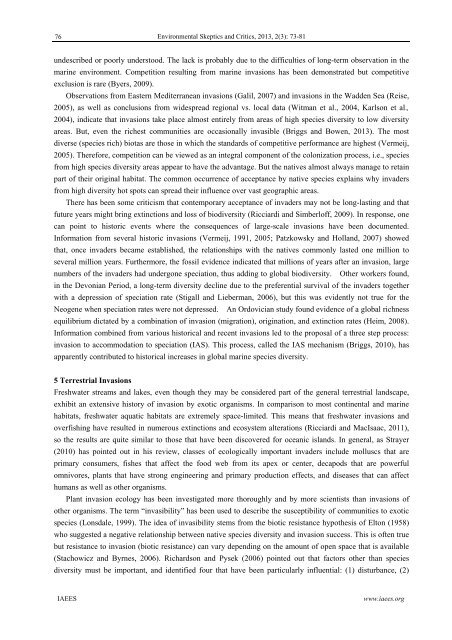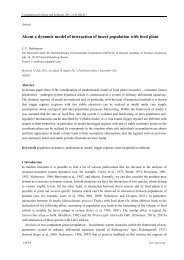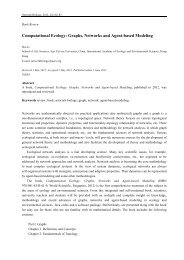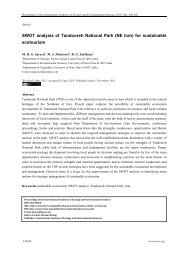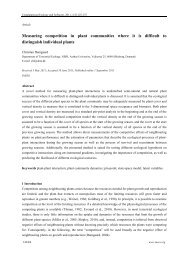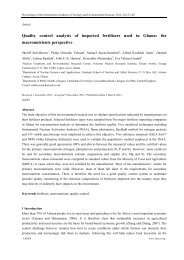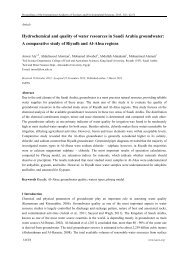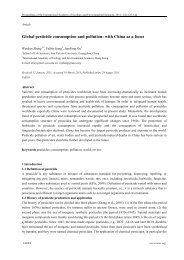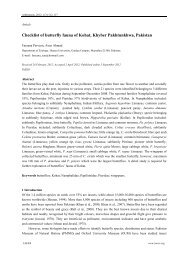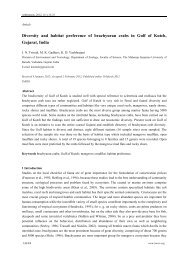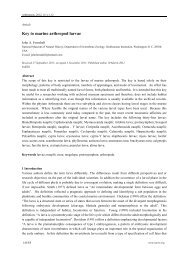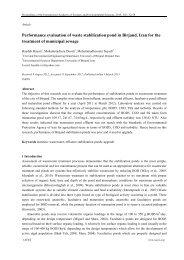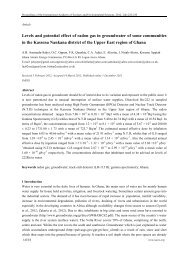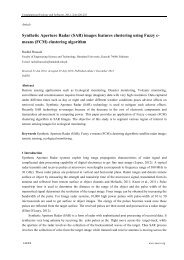Invasion ecology: Origin and biodiversity effects - JournalTOCs
Invasion ecology: Origin and biodiversity effects - JournalTOCs
Invasion ecology: Origin and biodiversity effects - JournalTOCs
You also want an ePaper? Increase the reach of your titles
YUMPU automatically turns print PDFs into web optimized ePapers that Google loves.
76<br />
Environmental Skeptics <strong>and</strong> Critics, 2013, 2(3): 73-81<br />
undescribed or poorly understood. The lack is probably due to the difficulties of long-term observation in the<br />
marine environment. Competition resulting from marine invasions has been demonstrated but competitive<br />
exclusion is rare (Byers, 2009).<br />
Observations from Eastern Mediterranean invasions (Galil, 2007) <strong>and</strong> invasions in the Wadden Sea (Reise,<br />
2005), as well as conclusions from widespread regional vs. local data (Witman et al., 2004, Karlson et al.,<br />
2004), indicate that invasions take place almost entirely from areas of high species diversity to low diversity<br />
areas. But, even the richest communities are occasionally invasible (Briggs <strong>and</strong> Bowen, 2013). The most<br />
diverse (species rich) biotas are those in which the st<strong>and</strong>ards of competitive performance are highest (Vermeij,<br />
2005). Therefore, competition can be viewed as an integral component of the colonization process, i.e., species<br />
from high species diversity areas appear to have the advantage. But the natives almost always manage to retain<br />
part of their original habitat. The common occurrence of acceptance by native species explains why invaders<br />
from high diversity hot spots can spread their influence over vast geographic areas.<br />
There has been some criticism that contemporary acceptance of invaders may not be long-lasting <strong>and</strong> that<br />
future years might bring extinctions <strong>and</strong> loss of <strong>biodiversity</strong> (Ricciardi <strong>and</strong> Simberloff, 2009). In response, one<br />
can point to historic events where the consequences of large-scale invasions have been documented.<br />
Information from several historic invasions (Vermeij, 1991, 2005; Patzkowsky <strong>and</strong> Holl<strong>and</strong>, 2007) showed<br />
that, once invaders became established, the relationships with the natives commonly lasted one million to<br />
several million years. Furthermore, the fossil evidence indicated that millions of years after an invasion, large<br />
numbers of the invaders had undergone speciation, thus adding to global <strong>biodiversity</strong>. Other workers found,<br />
in the Devonian Period, a long-term diversity decline due to the preferential survival of the invaders together<br />
with a depression of speciation rate (Stigall <strong>and</strong> Lieberman, 2006), but this was evidently not true for the<br />
Neogene when speciation rates were not depressed. An Ordovician study found evidence of a global richness<br />
equilibrium dictated by a combination of invasion (migration), origination, <strong>and</strong> extinction rates (Heim, 2008).<br />
Information combined from various historical <strong>and</strong> recent invasions led to the proposal of a three step process:<br />
invasion to accommodation to speciation (IAS). This process, called the IAS mechanism (Briggs, 2010), has<br />
apparently contributed to historical increases in global marine species diversity.<br />
5 Terrestrial <strong>Invasion</strong>s<br />
Freshwater streams <strong>and</strong> lakes, even though they may be considered part of the general terrestrial l<strong>and</strong>scape,<br />
exhibit an extensive history of invasion by exotic organisms. In comparison to most continental <strong>and</strong> marine<br />
habitats, freshwater aquatic habitats are extremely space-limited. This means that freshwater invasions <strong>and</strong><br />
overfishing have resulted in numerous extinctions <strong>and</strong> ecosystem alterations (Ricciardi <strong>and</strong> MacIsaac, 2011),<br />
so the results are quite similar to those that have been discovered for oceanic isl<strong>and</strong>s. In general, as Strayer<br />
(2010) has pointed out in his review, classes of ecologically important invaders include molluscs that are<br />
primary consumers, fishes that affect the food web from its apex or center, decapods that are powerful<br />
omnivores, plants that have strong engineering <strong>and</strong> primary production <strong>effects</strong>, <strong>and</strong> diseases that can affect<br />
humans as well as other organisms.<br />
Plant invasion <strong>ecology</strong> has been investigated more thoroughly <strong>and</strong> by more scientists than invasions of<br />
other organisms. The term “invasibility” has been used to describe the susceptibility of communities to exotic<br />
species (Lonsdale, 1999). The idea of invasibility stems from the biotic resistance hypothesis of Elton (1958)<br />
who suggested a negative relationship between native species diversity <strong>and</strong> invasion success. This is often true<br />
but resistance to invasion (biotic resistance) can vary depending on the amount of open space that is available<br />
(Stachowicz <strong>and</strong> Byrnes, 2006). Richardson <strong>and</strong> Pysek (2006) pointed out that factors other than species<br />
diversity must be important, <strong>and</strong> identified four that have been particularly influential: (1) disturbance, (2)<br />
IAEES<br />
www.iaees.org


